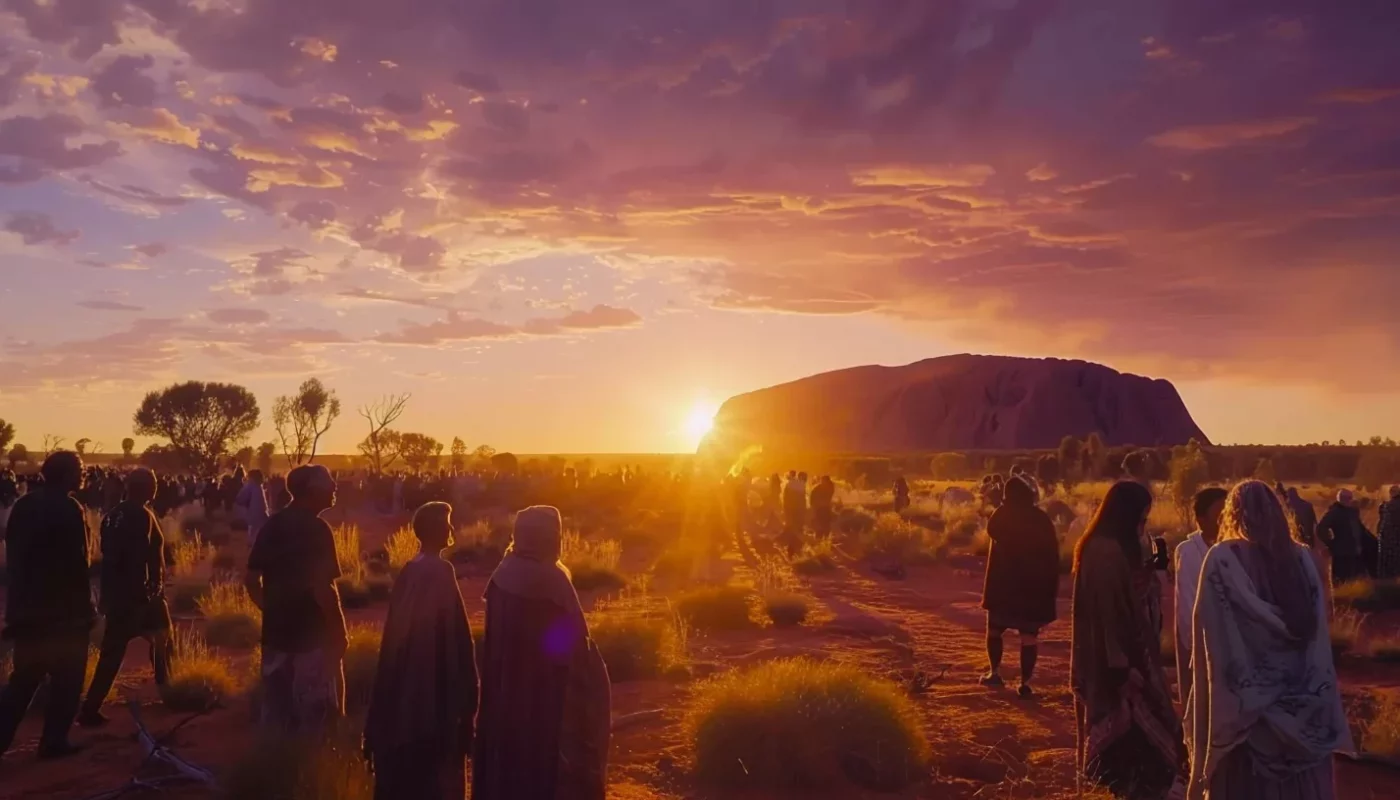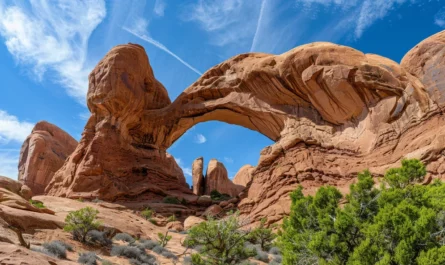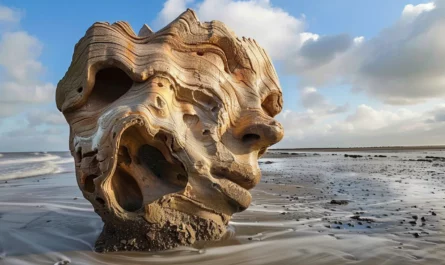Did you know about Uluru, often called Ayers Rock? It encircles a total of 9.4 kilometers (5.8 miles). This stunning monolith in the Northern Territory of Australia stands tall at 863 meters (2,831 feet). It’s one of Australia’s natural marvels and a sacred place for the indigenous Anangu people.
Uluru’s unique reddish color comes from iron oxide. This creates a dramatic change in color at sunrise and sunset. The combination of natural beauty and cultural history makes Uluru a key part of Australia’s heritage.
Uluru, along with the nearby Kata Tjuta formation, is part of the Uluṟu-Kata Tjuṯa National Park. This park got the UNESCO World Heritage Site tag in 1987. Ancient rock paintings and springs around the rock offer insights into Anangu traditions.
To keep the natural and cultural wonders of Uluru, conservation is key. The park follows strict rules to respect Indigenous practices and the environment. This helps Uluru stay a cherished site, showcasing Australia’s natural beauty.
Introduction to Uluru: A Natural Marvel
Uluru, also called Ayers Rock, stands as a striking feature of Australia’s landscape. Its huge size and bright colors capture the eyes of visitors from around the globe. People come for different Uluru tours. This large sandstone rock is more than just a stunning sight. It holds stories from Australia’s indigenous heritage that go back thousands of years.
The Anangu people have lived near Uluru for many generations. They see Uluru as a sacred place. The rock’s shapes and stories are a big part of their culture. This combination of natural beauty and cultural importance makes Uluru special. It links the past to the present.
Taking an Uluru tour is like going on an amazing trip. You’ll learn about the rock’s geology and the Anangu people’s culture. The sandstone formation of Uluru makes it a perfect place to explore old stories. Each part of Uluru has its own story to tell. This makes each visit a chance to learn more about Australia’s culture and spirituality.
We must protect Uluru for the future. Efforts are in place to keep this wonder safe. These actions help ensure that Uluru remains a symbol of Australia’s indigenous heritage. It continues to protect the Anangu people’s stories and traditions.
The Geological Significance of Uluru
Uluru stands tall, a giant among Australia’s inselbergs, drawing the interest of both geologists and nature lovers. This remarkable sandstone rock formation opens a portal to Earth’s ancient history. It shares insights into how it was formed and what it’s made of.
Formation and Composition
The story of Uluru’s creation is a testament to nature’s wonders. It took shape about 550-530 million years ago, during the Cambrian period. Made mostly of arkose, a sandstone filled with feldspar, Uluru showcases unique qualities.
Much of Uluru lies hidden beneath the Earth, with only its prominent peak seen above ground. Its vivid red color comes from iron oxide. This color glows under the Aussie sun, giving Uluru a magical look.
Height and Perimeter
Uluru’s size is truly impressive, making it a standout in the geological world. It reaches up to 863 meters (2,831 ft) and stretches across 9.4 kilometers (5.8 miles). These measurements highlight its isolation and magnitude.
This rock’s vast size and unique features make it central to Australia’s inselbergs. It invites both scientific curiosity and visitors from around the globe. Studying Uluru helps us learn about the geological forces at play on Earth.
Keeping Uluru in good condition is vital. Efforts by Uluru-Kata Tjuta National Park aim to protect it for the future. By managing tourism and caring for the environment, Uluru shines as a symbol of natural heritage.
Historical Background
The Australian Western Desert’s history is full of stories, especially about the Aboriginal Anangu people. It has been home to humans for over 10,000 years. For the Anangu people, with a culture dating back 60,000 years, Uluru is key to their beliefs and lifestyle.
In the 1870s, European explorers Ernest Giles and William Gosse arrived. They mapped the region and Gosse named Uluru as Ayers Rock, honoring Sir Henry Ayers. This time was marked by increased contact with the Anangu but also conflict and changes to the land and its people due to pastoralism.
Now, efforts are focused on protecting Uluru and its environment. Actions are taken to limit damage and encourage careful use of the area. These steps help respect the site’s history and the Anangu people’s traditions for the future.
Ancient Inhabitants
Uluru’s surrounding area has been home to people for more than 10,000 years. These original settlers were the Aboriginal Anangu. They have a strong connection to Uluru, seen in their many traditions, stories, and spiritual activities.
European Exploration
European explorers came to the Australian Western Desert in the 1870s, causing big changes. Ernest Giles and William Gosse named Uluru as Ayers Rock during their travels. This led to both cooperation and conflict with the Anangu people. The arrival of pastoralism also changed the desert, affecting its ecosystem and the people living there.
Cultural Importance to the Anangu People
Uluru means more to the Anangu people than just its location. It represents a deep, spiritual connection. To them, it is alive, holding their ancient laws called Tjukurpa. The rock’s features, like caves, are shaped by ancestral beings from their Dreamtime stories. These tales tell how the world was created, influencing the community’s way of life and responsibilities.
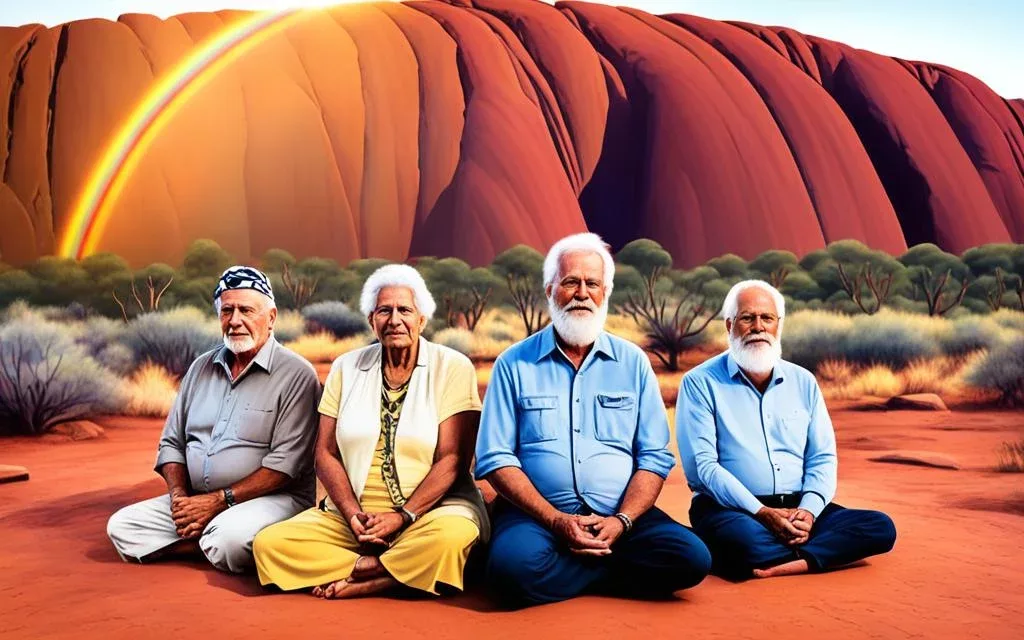
Spiritual Significance
Uluru is at the heart of Anangu spirituality, symbolizing their ancestors’ presence. It’s a sacred site for rituals that strengthen their bond with the land. These rituals are connected to Tjukurpa, showing the community’s ethical guidelines through Dreamtime stories. Each part of Uluru holds a story that brings spiritual lessons into everyday life.
Traditional Practices
At Uluru, traditional ceremonies are crucial in keeping sacred traditions alive. These include dances and songs, more than just art forms. They are sacred acts that link the Anangu to their ancestors. This ensures that their ancient stories and wisdom are carried on, preserving their culture.
Protecting Uluru goes beyond conservation of a site; it’s about keeping a rich culture alive. The Anangu and Australian authorities jointly manage Uluru-Kata Tjuta National Park. This partnership protects Uluru’s sacredness and environment for the future. It shows respect for the Anangu’s beliefs and Uluru’s lasting importance.
Tourism and Visitor Information
Since the late 1930s, Uluru has been a top spot for travelers worldwide. This landmark mixes natural beauty with deep cultural importance. Visitors enjoy Uluru tourism through guided tours, often led by the Anangu people. These tours explain the local plants, animals, and the Tjukurpa stories. These stories are key to the Anangu’s beliefs.
Guided Tours
Guided tours at Uluru focus on respecting the site’s sacredness while teaching visitors about its history and culture. They include walks among ancient rocks and stories of the Dreamtime. These tours show why visiting Ayers Rock is so enriching.
Best Times to Visit
The best time to visit Uluru is from May to September. This cooler time makes exploring Uluṟu-Kata Tjuṯa National Park more comfortable. Sunrise and sunset offer special moments to see Uluru and Kata Tjuta’s changing colors. These times add extra beauty to guided tours in Uluru.
Uluru is highly important culturally, so visitors must follow sacred sites regulations closely. These rules protect not just the land but also the Anangu people’s spiritual and cultural heritage. Efforts to conserve the area include respecting Indigenous customs and traditions.
Conservation Efforts
Conserving Uluru and its surroundings is crucial due to its spiritual, cultural, and natural value. Efforts in Uluru-Kata Tjuta National Park focus on biodiversity while honoring Indigenous traditions. This approach protects the land and uses Indigenous knowledge.
The work with the Anangu people is a key part of conservation here. Their knowledge helps manage the land in a way that’s sustainable and respectful. This blend of new methods and ancient wisdom keeps the park’s ecosystem balanced.
The park has started a strong visitor education program. It teaches tourists about Uluru’s importance and encourages them to visit responsibly. This effort includes sharing information about local plants, animals, and cultural sites.
“The conservation of Uluru is not just about preserving a landmark; it’s about maintaining a living cultural landscape. It integrates environmental stewardship with deep respect for the Anangu’s enduring connection to the land.”
The strategies at Uluru-Kata Tjuta National Park are an example for others. They show how to protect nature and culture together. This way, we can keep this sacred place safe for everyone in the future.
Significance of Dual Naming: Uluru / Ayers Rock
The dual naming policy of Uluru and Ayers Rock honors both Indigenous and European connections. It started in 1993, making it the first place in the Northern Territory with two official names.
This policy respects the original name, Uluru, and the name European settlers gave, Ayers Rock. In 2002, this method of naming got more support. William Gosse, in 1837, was the first outsider to see Uluru. He called it Ayers Rock after Sir Henry Ayers.
The dual naming policy shows the Anangu people’s strong bond with the land. They have lived near Uluru and Kata Tjuta for over 30,000 years. Since 1985, the Anangu and Parks Australia jointly manage the Uluru-Kata Tjuta National Park. The park protects around 80 rock art sites.
Learning about the culture at Uluru and Ayers Rock is a key experience. The Cultural Centre there teaches about Aboriginal traditions and stories. Also, tours from Alice Springs or longer trips to Uluru and Kings Canyon offer deep dives into this beautiful place.
The base walk at Uluru takes around three to four hours and provides opportunities to learn about the rock, see Aboriginal rock art, and explore native flora and fauna.
If you’re seeking an adventure, five areas around Uluru offer great sunrise and sunset views. Planning a visit here means getting deep into the natural and cultural wonders of these landmarks.
Protecting Uluru’s beauty is vital. The work of Parks Australia and the Anangu in managing it helps keep its treasures safe. This effort also teaches visitors to respect this sacred area, helping it last for more generations.
| Aspect | Significance |
|---|---|
| Dual Naming Policy | Recognition of Indigenous and European heritage, established 1993 |
| Historical European Connection | Named Ayers Rock by William Gosse in 1837 |
| Cultural Education | Uluru-Kata Tjuta Cultural Centre, rock art sites |
| Conservation | Joint management by Parks Australia and the Anangu |
Understanding Uluru and Ayers Rock’s dual names helps us value this site more. It shows the mix of old traditions and newer histories. This is why Uluru is such a loved landmark in the Northern Territory.
Experiences at the Uluru-Kata Tjuta National Park
The Uluru-Kata Tjuta National Park offers experiences that mix nature and culture beautifully. It’s where you find the famous Uluru and the impressive Kata Tjuta rocks. They showcase Australia’s Indigenous heritage.
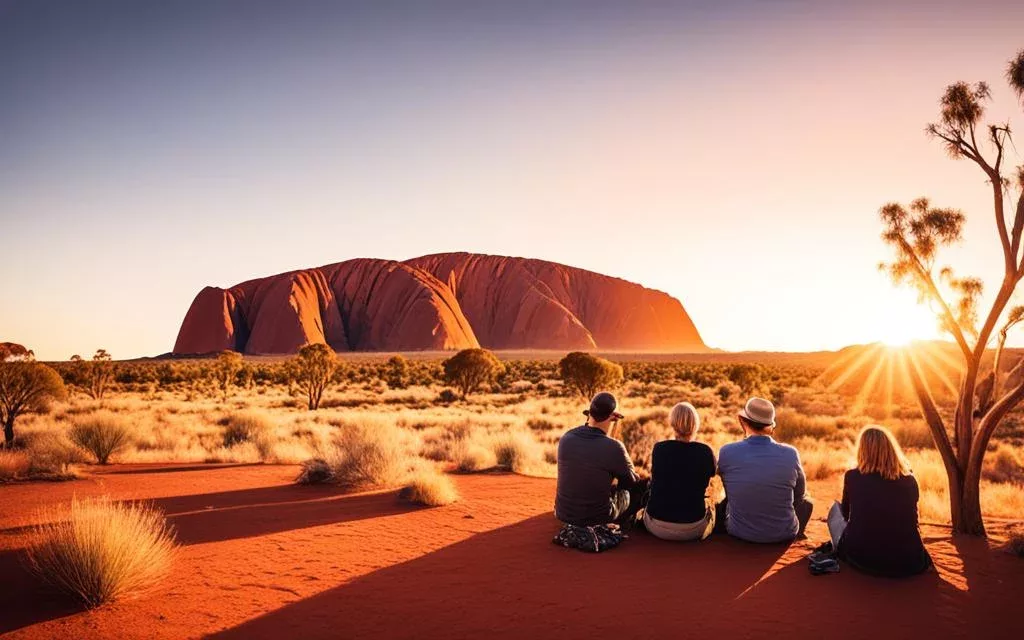
Kata Tjuta: The Olgas
Kata Tjuta, or The Olgas, are huge, rounded rocks about 25 kilometers from Uluru. They have 36 domes sacred to the Anangu people. There are walking trails for visitors to see the formations up close and enjoy the views.
Cultural Center
The park’s Aboriginal Cultural Centers share the Anangu people’s history and culture. They have art, ancient tools, and displays that tell the land’s stories. It’s key to understanding the Anangu’s bond with their land.
The park also works hard to protect its environment and Indigenous heritage. Conservation efforts ensure the survival of unique species and sacred places. This helps visitors appreciate the land’s beauty and cultural importance.
Uluru in Modern Context
Uluru has been important for over 60,000 years to the Anangu people. Nowadays, it faces both challenges and success stories. This is especially true in today’s Anangu society and how tourism affects Uluru.
Tourism Impact
Uluru is Australia’s top visitor spot, with millions coming every year. Tourism helps the Anangu people economically but brings big issues too. The area’s fragile environment can suffer from too many visitors.
The Anangu, as Uluru-Kata Tjuta National Park’s owners and protectors, stress sustainable tourism. They aim to protect the park’s special wildlife and keep Uluru sacred through conservation efforts.
Significant Events
Recent events at Ayers Rock highlight the balance between preserving culture and facing new challenges. In 1985, Uluru was given back to the Anangu, acknowledging their rights and involvement in managing the park. Then, in 2019, climbing Uluru was banned, respecting the Anangu’s wishes and the rock’s spiritual importance.
Merging modern tourism with respect for Anangu traditions shows progress. These changes are crucial for looking after this ancient, beloved place.
Read more about the significance of Uluru to Australian Indigenous culture
| Aspect | Data |
|---|---|
| Years of Existence (According to Anangu) | Over 60,000 years |
| Geological Age | About 500 million years |
| Estimated Indigenous Nations in Australia | 500 |
| Language Groups Across Australia | 260 |
| Tourist Visits Annually | Millions |
| Protected Areas Around Uluru | Uluru-Kata Tjuta National Park |
Conclusion
Uluru’s legacy shines as both a cultural icon and a natural wonder. It shows the Anangu people’s spiritual connections and traditions. This giant rock formation is not just a wonder of nature. It’s a symbol of Australia’s rich culture.
We must respect Aboriginal culture when visiting Uluru. The Anangu people share their spiritual ties to the land with us. It’s crucial to find a balance between tourism and preserving this culture. This ensures Uluru’s essence and environment are kept safe for the future.
Conserving Uluru is key for tourism’s future. The National Park and the Anangu work together to protect this place. Their goal is to keep Uluru as a place of learning and respect. It stands as a powerful symbol of Australia’s heritage and environmental care.

